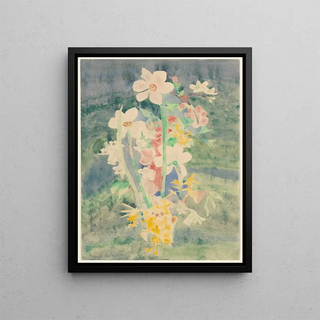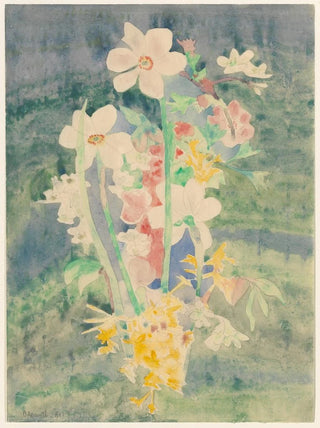Narcissus Painting - Charles Demuth | Art print


View from behind

Frame (optional)
The work "Narcissus" by Charles Demuth, painted in 1922, stands as a masterpiece within the American modernist movement. It embodies a bold fusion of abstraction and figuration, revealing the psychological depth of the mythological character while exploring themes of identity and perception. The painting, through its subtle use of color and form, invites us on an introspective journey, where the viewer is confronted with fleeting beauty and the solitude it entails. The depiction of Narcissus, this young man captivated by his own reflection, evokes a reflection on self-obsession and the quest for authenticity in a constantly changing world.
Style and uniqueness of the work
In "Narcissus," Demuth deploys a characteristic style that combines geometric precision with fluidity of forms. Sharp lines and vibrant colors blend to create an atmosphere that is both dreamlike and unsettling. The artist plays with light and shadow, emphasizing Narcissus's facial features while blurring the contours of his environment. This technique gives the piece an almost surreal dimension, where the boundary between reality and imagination blurs. The choice of colors, ranging from deep blues to bright yellows, evokes a rich emotional palette, highlighting the nuances of human psychology. Through this approach, Demuth manages to capture the very essence of the Narcissus myth, while offering a modern and personal interpretation that resonates with our era.
The artist and his influence
Charles Demuth, an iconic figure of the early 20th-century American art scene, made his mark through his boldness and unique vision. Influenced by European movements such as cubism and futurism, he developed a distinctive style that blends abstraction with figurative representation. Demuth was also a pioneer in the use of oil painting on canvas, enabling more vibrant and textured renditions. His work, like "Narcissus," reflects an unceasing quest for beauty and a reflection on the role of art in society.

Matte finish

View from behind

Frame (optional)
The work "Narcissus" by Charles Demuth, painted in 1922, stands as a masterpiece within the American modernist movement. It embodies a bold fusion of abstraction and figuration, revealing the psychological depth of the mythological character while exploring themes of identity and perception. The painting, through its subtle use of color and form, invites us on an introspective journey, where the viewer is confronted with fleeting beauty and the solitude it entails. The depiction of Narcissus, this young man captivated by his own reflection, evokes a reflection on self-obsession and the quest for authenticity in a constantly changing world.
Style and uniqueness of the work
In "Narcissus," Demuth deploys a characteristic style that combines geometric precision with fluidity of forms. Sharp lines and vibrant colors blend to create an atmosphere that is both dreamlike and unsettling. The artist plays with light and shadow, emphasizing Narcissus's facial features while blurring the contours of his environment. This technique gives the piece an almost surreal dimension, where the boundary between reality and imagination blurs. The choice of colors, ranging from deep blues to bright yellows, evokes a rich emotional palette, highlighting the nuances of human psychology. Through this approach, Demuth manages to capture the very essence of the Narcissus myth, while offering a modern and personal interpretation that resonates with our era.
The artist and his influence
Charles Demuth, an iconic figure of the early 20th-century American art scene, made his mark through his boldness and unique vision. Influenced by European movements such as cubism and futurism, he developed a distinctive style that blends abstraction with figurative representation. Demuth was also a pioneer in the use of oil painting on canvas, enabling more vibrant and textured renditions. His work, like "Narcissus," reflects an unceasing quest for beauty and a reflection on the role of art in society.
12,34 €






